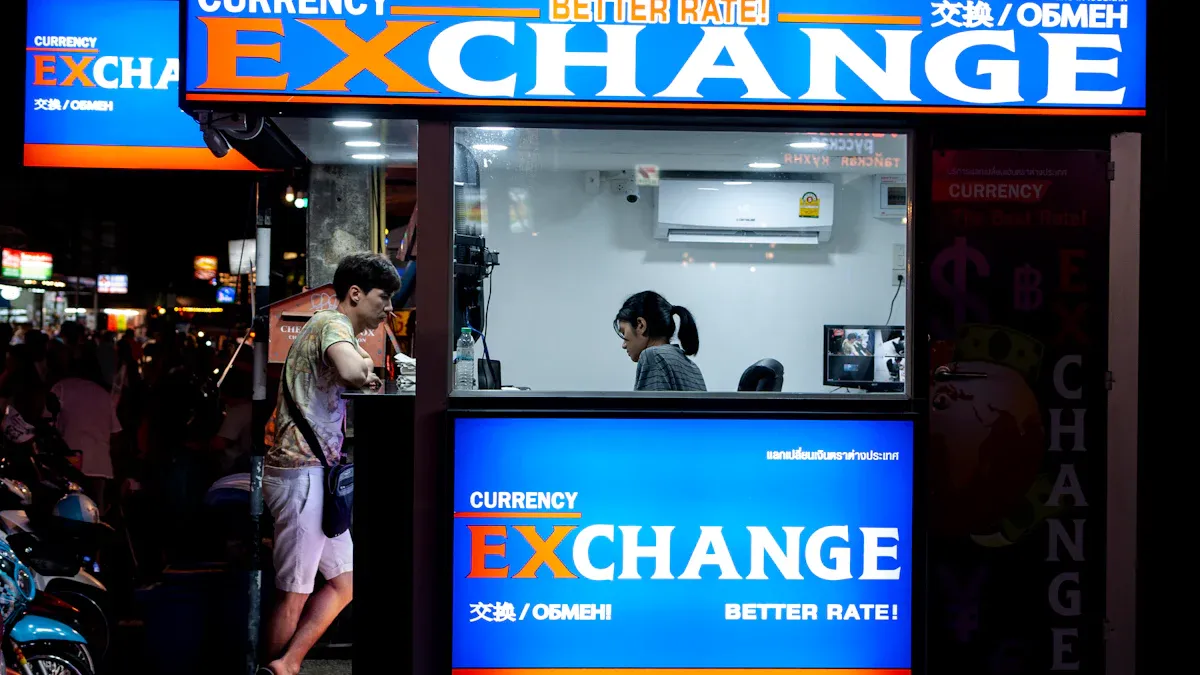- EasyCard
- Trade
- Help
- Announcement
- Academy
- SWIFT Code
- Iban Number
- Referral
- Customer Service
- Blog
- Creator
5 Innovative Foreign Trade Settlement Solutions to Bid Farewell to Exchange Rate Risks

Image Source: pexels
The market environment in 2025 is witnessing the integration of technology, policy, and demand, a trend that is reshaping the global payment landscape. Traditional settlement methods face dual challenges in efficiency and risk control. The continuous expansion of the global cross-border payment market highlights the urgency for enterprises to seek better solutions.
| Indicator | 2024 | 2025 |
|---|---|---|
| Cross-border payment market size (USD billion) | 201.34 | 217.69 |
| Compound annual growth rate (2024-2035) | 8.12% | 8.12% |
Faced with this situation, enterprises urgently need effective innovative solutions to manage funds and avoid risks.
Actively adopting advanced strategies can help enterprises transform exchange rate fluctuations from potential threats into competitive advantages that consolidate market positions.
Key Points
- Enterprises need new methods to manage funds and avoid risks brought by exchange rate changes.
- Forward contracts can help enterprises determine future exchange rates in advance, making income and expenses more stable.
- Currency options act like insurance, allowing enterprises to choose whether to trade at the agreed exchange rate, both avoiding risks and seizing good opportunities.
- Multi-currency accounts enable enterprises to manage multiple currencies in one place, reducing the hassle and costs of currency conversion.
- Fintech platforms provide small and medium-sized enterprises with cheaper and faster international payment methods, helping them conduct business better.
Forward Contracts: A Classic Innovative Solution for Exchange Rate Risk Hedging

Image Source: unsplash
Forward contracts are a time-honored and highly effective exchange rate risk management tool. They allow enterprises to sign contracts with banks (such as licensed banks in Hong Kong) to agree on buying or selling a specific amount of foreign currency at a pre-locked exchange rate on a specific future date. This approach provides certainty for enterprises’ future cash flows.
Core Principles and Operations
The core of forward contracts lies in “locking in the future.” If an enterprise has a $1 million receivable due in 90 days, it can immediately sign a forward contract to lock in the USD exchange rate 90 days later. Regardless of how the market exchange rate fluctuates at that time, the enterprise will settle at the agreed rate, thereby eliminating uncertainty.
In terms of operations, forward contracts are divided into two main types:
| Feature | Deliverable Forward Contracts (DF) | Non-Deliverable Forward Contracts (NDF) |
|---|---|---|
| Asset exchange | Involves actual delivery of the underlying currency | No physical delivery, only cash settlement |
| Settlement method | Exchange currencies at the agreed rate upon maturity | Settle the difference between the agreed rate and the spot rate |
| Primary use | Suitable for enterprises with actual foreign exchange receipt and payment needs | Used for hedging risks of regulated or illiquid currencies |
Enterprises can choose the most suitable contract type based on their actual trade needs.
Applicable Scenarios and Advantages
This solution is most suitable for enterprises with confirmed future foreign currency receipts and payments, especially industries with low profit margins and sensitivity to exchange rate fluctuations. Its greatest advantage lies in certainty. By locking in costs or revenues, enterprises can focus on core business operations without being distracted by daily exchange rate fluctuations.
For example, The Walt Disney Company faced risks from yen exchange rate fluctuations in the 1980s because its Tokyo park royalty fees were denominated in yen. At that time, the company considered using forward contracts and other tools to lock in the exchange rate, protecting its USD revenues from yen depreciation. This demonstrates how large multinational companies use this classic tool to stabilize financial expectations.
Opportunity Costs and Countermeasures
Although forward contracts can effectively hedge risks, they also come with opportunity costs.
If the market exchange rate moves in a favorable direction after signing the contract, the enterprise will not be able to enjoy the more favorable rate, as it must fulfill the contract. This is the “price” enterprises pay for certainty.
An effective countermeasure is partial hedging. Enterprises can choose not to lock in 100% of the risk exposure but hedge 50%-80% of it instead. This provides protection for most operations while retaining some exposure to benefit from favorable exchange rate movements. This flexible hedging strategy makes the classic forward contract a versatile innovative solution.
Currency Options: A Flexible Tool Balancing Risk Avoidance and Potential Gains
If forward contracts are like putting a “safety lock” on exchange rate risks, then currency options are more like “insurance.” They provide enterprises with the right, but not the obligation, to buy or sell foreign currency at an agreed rate on a specific future date. Enterprises pay a fee for this right, known as the option premium. This model grants enterprises great flexibility.
Core Principles and Operations
The core of currency options lies in the “right to choose.” After paying the option premium, enterprises gain the choice to respond to future exchange rate fluctuations. If the market rate moves unfavorably, enterprises can exercise the option and settle at the preset favorable rate; if the market rate moves favorably, enterprises can choose not to exercise and settle directly at the better spot market rate, with the maximum loss being only the premium already paid.
In terms of operations, there are two basic types:
| Option Type | Definition | Applicable Operations |
|---|---|---|
| Call Option | Grants the holder the right to buy a currency at an agreed price. | Suitable for enterprises with future foreign currency payment needs to cap the cost of purchasing foreign exchange. |
| Put Option | Grants the holder the right to sell a currency at an agreed price. | Suitable for enterprises with future foreign currency income to set a floor for settlement income. |
Applicable Scenarios and Advantages
The greatest advantage of currency options as an innovative solution is that they both hedge risks and do not forgo potential gains. They are perfectly suited for business scenarios with uncertain cash flows.
Suppose a transaction initially agrees to pay 85,000 GBP. If the future exchange rate worsens and requires 90,000 GBP at the spot rate, the enterprise can still exercise the option and complete the payment at the agreed 85,000 GBP. But if the exchange rate becomes more favorable and only requires 80,000 GBP, the enterprise can forgo the option and trade directly at the market rate, thereby saving costs.
This flexibility is particularly critical in the following scenarios:
- Uncertain cash flows: For example, participating in project bids without certainty of winning; or awaiting approval for overseas investment returns.
- Mergers and acquisitions: Uncertainty about whether the transaction will ultimately close.
- Fixed asset sales: Sale timing and final price not fully determined.
Option Premium Cost Considerations
Enterprises need to pay an option premium to obtain this valuable right of choice. The level of the premium is mainly influenced by two core factors: volatility and time to expiration.
- Volatility: The more intense the price fluctuations of the currency pair, the greater the uncertainty of its future direction, the higher the option value, and thus the more expensive the premium. Around major market events (such as elections or interest rate decisions), short-term volatility may surge, pushing up option costs.
- Time to Expiration: The longer the option’s validity period, the more time it gives the holder to wait for favorable prices, increasing uncertainty accordingly. Therefore, long-term options are generally more expensive than short-term ones.
When selecting options, enterprises need to comprehensively assess their risk tolerance and cost budget to find the best balance.
Multi-Currency Accounts: Building an Integrated Domestic and Foreign Currency Fund Pool
Unlike transactional tools such as forwards and options, multi-currency accounts are a structural innovation in fund management. They allow enterprises to hold, manage, and receive/pay multiple currencies under a single account system. This model is becoming the cornerstone of enterprises’ global fund management, especially with policy support amplifying its advantages.
This solution aligns with China’s policy trend of piloting “cross-border corporate domestic and foreign currency integrated fund pool operations.” The policy aims to simplify cross-border fund flows and enhance corporate fund operation efficiency.
Core Principles and Operations
The core of multi-currency accounts is “fund pool management” and “multi-currency automatic aggregation.” Enterprises can deposit income from around the world in USD, EUR, JPY, etc., into the same account system without immediate conversion to a single currency. When payments are needed, they can be made directly from the balance of the corresponding currency.
This operating model achieves “natural hedging.” For example, an enterprise receives $1 million in payment for goods and needs to pay €800,000 for procurement. In a multi-currency account, these two funds can exist independently. The enterprise only needs to convert the remaining USD into the required currency, rather than converting all USD income, significantly reducing unnecessary currency conversions and related costs.
Applicable Scenarios and Advantages
Multi-currency accounts are particularly suitable for foreign trade enterprises with global operations and diverse receipt/payment currencies. Their core advantages lie in significantly reducing costs and improving efficiency.
- Reduce exchange costs: Achieve natural hedging through “same-currency receipts and payments,” avoiding frequent exchange losses and fees.
- Improve fund efficiency: Centralized fund management reduces the hassle of opening multiple single-currency accounts at different banks, allowing finance personnel to clearly grasp global fund status.
- Leverage policy dividends: China’s domestic and foreign currency integrated fund pool pilot allows enterprises greater freedom to mobilize cross-border funds and use domestic and foreign exchange derivatives for risk hedging.
A manufacturing industry client implemented a multi-currency notional cash pool, automating 90% of internal loan records and achieving annual savings of approximately $500,000. These savings came from reduced foreign exchange fees and optimized liquidity.
Key Points for Selecting Service Providers
Choosing the right service provider is key to successfully implementing a multi-currency account strategy. When selecting, enterprises should focus on whether the provider has the following capabilities:
- Support for regional innovation policies: Examine whether the service provider (such as certain licensed banks in Hong Kong) can support innovative foreign exchange policies in Free Trade Zones (FTZ). For example, Free Trade (FT) accounts provided in Shanghai and Hainan FTZs allow freer transfers between accounts and simplify currency exchange processes.
- Transparent fee structure: Carefully evaluate monthly fees, transaction costs, currency conversion spreads, etc. The average transaction fee for international payments is typically between 1-3%, and excessively high rates will erode profits.
- Global account network: A robust global account network ensures that enterprises can achieve local clearing in major trading partner countries, further reducing cross-border payment costs and settlement times.
Fintech Platforms: Efficiency Tools for SMEs Going Global

Image Source: pexels
For small and medium-sized enterprises (SMEs) with limited budgets and resources, fintech platforms are powerful innovative solutions for managing cross-border payments. These platforms bypass the complex intermediary links of traditional banks, providing enterprises with more efficient and economical global fund settlement options.
Core Principles and Operations
The core of fintech platforms lies in using technology to simplify payment processes. Platforms like Wise, Payoneer, and Airwallex connect local payment systems in different countries and regions directly through their global clearing networks. When enterprises need to make payments, funds typically flow within the platform’s internal network rather than through multiple correspondent banks. This greatly shortens settlement times and reduces costs.
In terms of operations, enterprises only need to register an account online to gain multi-currency receipt capabilities. They usually offer quotes close to mid-market exchange rates with a more transparent fee structure.
- Transparent pricing: Display all fees upfront, allowing users to clearly understand transaction costs.
- Simplified transactions: Achieve fast or even instant international payments through modern technology.
- User-friendly: Intuitive online platforms make it easy for users to complete cross-border remittances.
Applicable Scenarios and Advantages
Fintech platforms are particularly suitable for SMEs with frequent transactions, diverse currencies, and cost sensitivity. Their advantages lie not only in direct cost savings but also in improved operational efficiency.
Many enterprises have significantly reduced transaction fees and operational complexity by adopting fintech platforms. For example, international B2B company Wayo optimized costs after using Airwallex, while German trading company Workinghouse UG saved valuable time and gained transparent real-time exchange rates through iBanFirst.
More importantly, these platforms serve a “credit enhancement” role. SMEs can build clear and traceable transaction records through platforms, helping prove business stability and compliance to traditional banks. This makes it easier for them to be included in the “premium enterprise” category by banks, thereby enjoying more convenient settlement policies in the future.
Compliance and Security Considerations
When choosing fintech platforms, compliance and security are primary considerations. Reputable platforms hold corresponding licenses in major global markets and strictly comply with local regulatory requirements, such as China’s payment licenses and data security regulations.
To ensure fund security, these platforms generally adopt bank-grade security measures:
| Security Measure | Specific Application |
|---|---|
| Data encryption | Use advanced encryption standards like AES-256 to protect data in transit and at rest. |
| Identity verification | Implement multi-factor authentication (MFA) and strict KYC (Know Your Customer) processes. |
| Fraud detection | Deploy AI-driven real-time transaction monitoring systems to identify and flag abnormal activities. |
Before selecting a service provider, enterprises should carefully verify its regulatory qualifications and security protocols to ensure funds are fully protected.
Blockchain Settlement: Exploring Next-Generation Innovative Solutions
Blockchain technology represents the most forward-looking innovative solution in the cross-border payment field. It provides enterprises with the possibility of bypassing traditional financial intermediaries and achieving peer-to-peer direct settlement through decentralized distributed ledger technology (DLT).
Core Principles and Operations
The core of blockchain is establishing a shared, tamper-proof transaction record. Every participant in the network has a copy of the ledger, and all transactions must be verified by multiple parties before being recorded. This mechanism eliminates reliance on centralized institutions like banks.
Smart contracts are a key component. These are programmatically executed contracts that automatically release funds when preset conditions (such as goods delivered) are met. This greatly simplifies processes and reduces counterparty risks.
In terms of operations, enterprises can use blockchain-based platforms for settlement. For example, Bitcoin and its Layer 2 solution Lightning Network allow funds to be transferred in seconds at extremely low cost. This contrasts sharply with traditional banking systems.
| Feature | Blockchain Settlement | Traditional Bank Transfer |
|---|---|---|
| Intermediary | None, peer-to-peer transactions | Relies on multiple intermediary banks |
| Speed | Near-instant | May take several days |
| Cost | Significantly reduced | Higher |
| Transparency | Fully transparent | Opaque |
Forward-Looking Advantages and Scenarios
Blockchain’s forward-looking advantages lie in its ability to reshape complex trade processes, especially in supply chain finance. Traditional trade relies on extensive paper documents, which is inefficient and error-prone. Blockchain can digitize bills of lading, invoices, and other documents and securely record them on the chain.
This provides new ideas for addressing the global trade finance gap. It is estimated that the global trade finance supply-demand gap reaches up to $1.5 trillion. By establishing credible transaction records on the blockchain, SMEs can more easily prove their credit and obtain financing. For example, when the system confirms that the seller has shipped, financing institutions can provide funds to the seller in advance based on this credible data.
Current Challenges and Outlook
Despite its promising prospects, the widespread application of blockchain settlement still faces three major challenges:
- Regulatory uncertainty: Regulatory policies vary globally and are still evolving, posing compliance challenges for enterprises. For example, anti-money laundering (AML) and Know Your Customer (KYC) requirements are difficult to uniformly implement on decentralized systems.
- Scalability issues: Mainstream blockchain networks (such as Bitcoin and Ethereum) have limited transactions per second, far below traditional payment systems like Visa, potentially causing congestion in high-frequency transaction scenarios.
- Interoperability barriers: Multiple different blockchain platforms currently exist without unified standards, making seamless integration with enterprises’ existing financial and banking systems difficult.
Looking ahead, as technology matures and regulatory frameworks improve, blockchain is expected to evolve from an exploratory option into one of the mainstream tools for foreign trade settlement, bringing higher efficiency and security to global trade.
The approach to managing exchange rate risks for enterprises is shifting from single-tool hedging to building integrated fund management systems. The five innovative solutions discussed in this article, from classic forward contracts to cutting-edge blockchain settlement, collectively form this system. Enterprises should proactively assess their business models and policy environments, integrating the most suitable solutions to embrace change. Looking forward, foreign exchange settlement will deeply integrate with AI risk control, with AI providing predictive insights through analyzing massive data to enhance decision-making efficiency.
Continuous learning and proactive adaptation are key for enterprises to remain invincible in 2025 and beyond.
FAQ
Which solution should SMEs prioritize?
Fintech platforms are usually the first choice for SMEs due to their low cost and high efficiency. For transactions with confirmed receipt dates, enterprises can also consider forward contracts to lock in profits. The final choice depends on the enterprise’s specific business needs and risk preferences.
How to effectively control the costs of hedging tools?
Enterprises can adopt partial hedging strategies, locking only part of the risk exposure. For currency options, enterprises need to evaluate the premium against potential gains. Choosing options with lower volatility or shorter terms can reduce upfront costs.
Can blockchain settlement be practically applied now?
Blockchain settlement is still in the exploratory stage, facing regulatory and technical challenges. Currently, it is more suitable for enterprises highly interested in technological innovation to conduct small-scale pilots and has not yet become a mainstream settlement tool.
What specific help does the Free Trade Zone (FTZ) policy provide for foreign exchange management?
FTZ policies (such as FT accounts in Shanghai or Hainan) simplify cross-border fund transfer processes. They allow enterprises greater freedom to mobilize domestic and foreign currency funds and utilize domestic and foreign exchange derivatives, significantly enhancing fund management efficiency and flexibility.
*This article is provided for general information purposes and does not constitute legal, tax or other professional advice from BiyaPay or its subsidiaries and its affiliates, and it is not intended as a substitute for obtaining advice from a financial advisor or any other professional.
We make no representations, warranties or warranties, express or implied, as to the accuracy, completeness or timeliness of the contents of this publication.




Contact Us
Company and Team
BiyaPay Products
Customer Services
is a broker-dealer registered with the U.S. Securities and Exchange Commission (SEC) (No.: 802-127417), member of the Financial Industry Regulatory Authority (FINRA) (CRD: 325027), member of the Securities Investor Protection Corporation (SIPC), and regulated by FINRA and SEC.
registered with the US Financial Crimes Enforcement Network (FinCEN), as a Money Services Business (MSB), registration number: 31000218637349, and regulated by FinCEN.
registered as Financial Service Provider (FSP number: FSP1007221) in New Zealand, and is a member of the Financial Dispute Resolution Scheme, a New Zealand independent dispute resolution service provider.



















